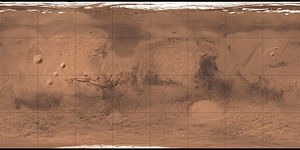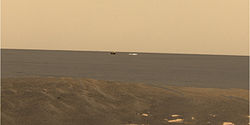Meridiani Planum
| Plateau on Mars | ||
|---|---|---|
| Meridiani Planum | ||

|
||
| Image of Meridiani Planum. The hematite deposits have been marked in color. The ellipse indicates the landing area of the Opportunity probe |
||
|
|
||
| position | 12 ° 0 ′ N , 0 ° 0 ′ E | |
Meridiani Planum or Terra Meridiani (the middle level) is an extensive plateau (planum) on the planet Mars .
Since Meridiani Planum shows a noticeable dark structure in the telescope at the level of the Martian equator, it was chosen as the reference point for the longitude and latitude of the planet. Therefore the prime meridian runs through Meridiani Planum.
In spectroscopic examinations of Mars orbit of the mineral were in the plane occurrence hematite found. It was therefore chosen as a landing site for a mission to Mars. Hematite forms on earth in hot springs or standing water. In addition, volcanic basalts and impact craters can be found in Meridiani Planum .
On January 25, 2004, the Opportunity spacecraft landed in a smaller crater ( Eagle Crater ) in the Meridiani Planum. Sedimentary structures are visible in the area of the landing site . Highly enlarged images show mineral concretions of hematite as well as cavities in rocks that were apparently formed by liquid water. The rocks are rich in magnesium sulphates and other sulphates such as jarosite .
Results from the Opportunity Mission so far indicate that the Meridiani Planum area has historically been exposed to liquid water for extended periods of time.
On October 19, 2016, the European - Russian Schiaparelli country landed in the planum. The lander is part of the ExoMars project of the European space agency ESA and the Russian space agency Roskosmos for the exploration of Mars. The plain is of particular interest to scientists because it contains hematite - an iron oxide that occurs almost exclusively on Earth in environments with liquid water.
Geology of the Meridiani Plain
This map shows the geological structures in the region of the Meridiani Plain, which has been explored by the Mars rover Opportunity since 2004.
The southern region, shaded blue here, is an old and cratered landscape. The northern region is overlaid by younger sediments of the Meridiani Plain, only broken through by the even younger Bopolu impact crater.
Old and cratered soil is also revealed around Endeavor Crater . Observations from Mars orbit have discovered sheet silicates there and at two other locations . The occurrence of these silicates is related to the previous presence of water.
See also
Web links
- DLR: Volcanic ash deposits in impact craters on Mars May 12, 2010


